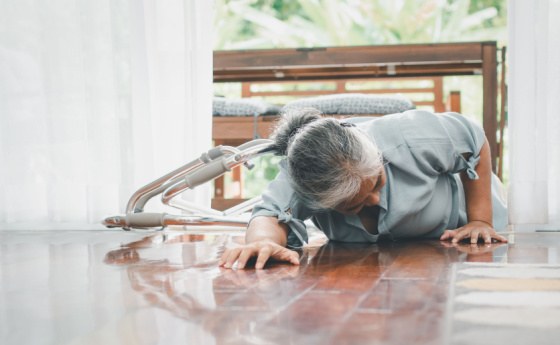- Emergency Ambulance Services
- 8606811111
- 0471-4077777, 0471-7177888
- gro@sutpattom.com
Prevention of fall in elderly
Dr. Anand Raja, Consultant Physiatrist, SUT Hospital, Pattom
Falls are very common in the elderly. They have devastating consequences. Falls are the leading cause of trauma-related injury and death in adults over the age of 65. Studies indicate that 1 in 3 adult in a community falls and sustains injuries each year. 24% of those who fall suffer serious injuries and 6% of them suffer fractures.
A person who falls may experience pain, hospital admission, surgery, nursing home admission, decreased overall functional capacity, poor quality of life, or fear of falling. This may force the elderly to avoid activities such as going out for walks, shopping, and participating in social activities.
Fear of falling is a defined geriatric syndrome. These can further reduce the functional capacity of already frail elderly people. When we experience something unpleasant, our natural reaction is to abhor that experience. So there is no wonder that people may begin to limit their activities after a fall. For the elderly, a more sedentary lifestyle leads to physical deterioration in addition to age-related problems. This increases the chance of fall.
Normal gait requires freely moving joints and strong muscles that contract at the right time with the right amount of force; and requires accurate visual, vibratory, and proprioceptive input. As we age, joints stiffen, muscle strength declines, and neurological feedback is impaired. These changes, combined with other risk factors, increase the risk of falling.
Risk factors for falls
- Previous falls
- Weak gait/ balance disorders
- Use of psychoactive drugs
- Visual impairment
- Polypharmacy
- Depression
- Dizziness
- Orthostasis
- Functional limitations
- Age > 80 years
- Low body mass index
- Urinary incontinence
- Cognitive impairment
- Arthritis
- Diabetes
The risk of falling increases with the number of risk factors present. A study shows that a person with 4 risk factors has a 78% chance of falling. Although risk assessment and multifactorial interventions can reduce falls by upto 40% in community-dwelling adults, appropriate multifactorial interventions to prevent ambulatory falls may include any or all of the following:
Exercise/physical therapy programs aimed at improving balance, flexibility, muscle strength, etc. are very effective in preventing falls.
- Discontinue or reduce psycho-active medications.
- Treat orthostatic hypotension.
- Changes in footwear to manage foot problems.
- Modification of the home environment.
- Awareness of patient and caregiver.
- Vitamin D supplementation in patients with Vitamin D deficiency or high risk of falls.
How to modify the home environment?
- Ensure good lighting at home.
- Install night lights in bedrooms, bathrooms and hallways.
- Keep a lamp within reach of the bed if you have to wake up in the middle of the night.
- Place light switches near room entrances.
- Using glow-in-the-dark or illuminated switches is more effective.
- Turn on lights before going up or down stairs.
- Keep flashlights in easy-to-find locations in case of power outages.
- Remove boxes, newspapers, electrical cords and phone cords from walkways.
- Remove coffee tables, magazine racks, plant stands, etc. from crowded areas.
- Secure loose floor rugs with double-faced tape – or remove loose rugs from the home altogether.
- Keep clothes, dishes, food and other essentials within easy reach.
- Clean up spilled liquids, oil and food immediately. Use non-slip mats in bathrooms.
- Use a bath seat that allows you to sit while showering.
Elevated toilet seats, armrests, grab bars, hand rails, and hand-held shower nozzles can all help reduce falls. Use assistive devices such as a cane walker and quadripod to maintain balance while standing as prescribed by your doctor. Determining the risk of falls and practicing exercises included in a ‘fall prevention program’ under the supervision of a physical medicine and rehabilitation physician can minimize falls in the elderly. By preventing falls, the quality of life can be greatly improved.









